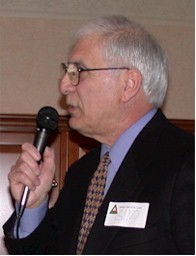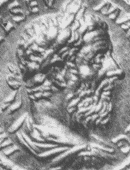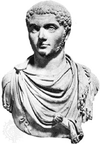
MAY MEETING
ORAZIO AND ARTEMISIA GENTILESCHI
|
| On June 14, the Saint Louis Art Museum opens the exhibition,
Orazio
and Artemisia Gentileschi: Father and Daughter Painters in Baroque Italy,
which brings together 65 paintings by Orazio (1573-1639) and Artemisia
(1593-1652/53). Judith Mann, Curator of Early European Art
at the Saint Louis Art Museum and one of the two organizers of this exhibition,
will give a slide presentation of works from the exhibition.
Both artists came under the influence of the Michelangelo
Merisi da Caravaggio, whose revolutionary style of bold naturalism had
a profound impact on early 17th-century art. Orazio trained his daughter,
and her early works show the influence of the father
In 1611, Artemisia was raped by Agostino Tassi, a colleague
of her father; a trial ensued during which Tassi was found guilty and exiled
from Rome. After the trial, Artemisia and her father parted ways
and lived apart for the next 25 years. Near the end of Orazio's life,
when he was working at the court of King Charles I of England, Artemisia
traveled to London and was there for an undetermined amount of time.
After Orazio died in 1639, she returned to Naples and spent the final period
of her life there.
Dr. Mann will give an overview of the lives of these two
fascinating baroque painters, whose works embody some of the salient stylistic
trends of seventeenth-century art, including baroque dynamism, refined
classicism, and extreme naturalism.
|
|
Next Meeting Wednesday, May 15, 2002
Cocktails 6:30 PM - Dinner 7:00 PM
Da Baldo's Restaurant
RSVP Marie Wehrle
(314) 544-8899
or by email
|

RECAP OF MARCH
MEETING
GALILEO AND THE HOLY INQUISITION
|
| Galileo Galilei (1564-1642) was the foremost scientist
of his day. He was described in his own time by the Grand Duke of
Tuscany, Ferdinando de Medici, as “the greatest light of our time,” later
he was indirectly praised by Isaac Newton with the statement that he (Newton)
accomplished what he did “because he “stood on the shoulders of giants,”
and, more recently, was pronounced by Albert Einstein “the father of modern
physics.” The April speaker, however, Dr. Salvatore Sutera,
himself a distinguished professor of engineering, chose not to focus on
Galileo the scientist, but rather on Galileo the defendant in the famous
trial for the crime of heresy before the Church’s Holy Office of the Inquisition.
In 1630, Galileo published his Dialogue on Two Chief
World Systems: Ptolemaic and Copernican, a dissertation on the
two rival theories of cosmology. Based on his research using the
telescope he himself had built, Galileo defended the Copernican theory
that the Sun is the center of the solar system over the theory developed
by Ptolemy and based on Aristotle that the earth was the center of the
universe. Galileo’s enemies in Rome argued that this was scandalous
and heretical because it contradicted the Bible. The Pope was pressured
to react, the book was banned in 1632, and Galileo was summoned to Rome
to stand trial. Sixty-eight years old and seriously ill, Galileo
made out his will and left for Rome in January 1633.
His interrogation began on April 12, 1633 during which
Galileo claimed he did not defend the Copernican theory. On April
30, at his second formal hearing, Galileo admitted to errors of vainglorious
ambition and ignorance. On May 10 he presented a formal written defense.
In his final interrogation, on June 21, he denied Copernicus, confessed
his “error”, pleaded for mercy, and signed a handwritten confession.
Convicted of heinous crimes, his sentence to formal imprisonment was pronounced
at the Tuscan embassy on June 22, 1634. The famous, but unproven,
legend persists that after sentencing he was heard to mutter, “eppur si
muove” (“and yet it moves”).
The Pope denied a request for pardon but allowed Galileo
to spend the first 5 months of imprisonment in custody of the archbishop
of Siena. He passed the balance of his sentence in house arrest in
the town of Arcetri, near Florence where he died January 8, 1642.
Galileo’s Dialogue remained on the Index of Prohibited
Books until 1835. In 1979, Pope John Paul II called for a re-examination
of the Galileo case and in 1992 he publicly endorsed Galileo’s philosophy.
Dr. Sutera based his presentation on the 1999 book Galileo’s
Daughter by Dava Sobel, itself based on 124 letters written by Galileo’s
oldest daughter, Suor Maria Celeste, a cloistered nun of the Order
of the Poor Clares in the convent of San Matteo in Arcetri, to her famous
father during the time of his clash with the Church. These letters
give a great insight into the nature and personality of Galileo and into
the relationship between father and daughter. Only the daughter’s
letters are extant. Galileo’s letters to her were destroyed by the
Mother Abbess of Suor Maria Celeste’s convent after her death in 1634.
In all, Galileo had three children with Marina Gamba:
Virginia (1600-1634) who became Suor M. Celeste; Livia, (1601-1649), who
also entered the convent of San Matteo, taking the name Suor Arcangela;
and Vincenzio (1606-1649). All were illegitimate; however Vincenzio
was legitimatised in 1619 by order of Ferdinando, Grand Duke of Tuscany.
Salvatore P. Sutera, Ph.D. is the Spencer T. Olin Professor
of Biomedical Engineering at Washington University and a member of the
Italian Club.
|
|

L’ANGOLO DEL PRESIDENTE
By Gene Mariani |
 |
|
WELCOME NEW MEMBERS
|
We are pleased to extend a warm welcome to Jeanine Anne Cicenia,
who was elected a member of the Club at our April meeting. Jeanine’s
family origins are from the Regions of Campania and Sicilia. Benvenuta,
Jeanine.
|
MRS. BETTY LANGE
|
| On behalf of the Italian Club, we wish to extend our sympathy and condolences
to member Raymond Lange on the death of his wife, Betty Lange on
April 18. |
|
ITALIAN HERITAGE AWARD
|
| Annually, at its June meeting, the Club presents its Italian Heritage
Award to an individual who has distinguished him or herself through unselfish
community service. Members who would like to nominate someone for
the award should submit their nominations to Club Secretary Marie Cuccia-Brand
either by email at mcucciasbj@aol.com or by phone at 314-993-2252.
Please include a brief explanation giving the reasons why you think the
person should receive the award. |

|
ANNOUNCEMENTS
CONGRATULATIONS, FATHER BENEDICT
|
On April 28, 2002, the Degree of Master of Sacred Theology was conferred
on Father Benedict Thomas Viviano, O.P., M.A., Ph.D., S.S.L.
This is the highest honor the Dominican Order confers on brothers outstanding
in teaching, research, and writing. Father Viviano, a frequent
speaker at both the Italian Club and Italiano per piacere meetings,
is the brother of member Patty Viviano and nephew of member Orsoline
Chiappetta. Congratulazioni, caro Padre Viviano.
|
|

ITALIAN CLUB STUDENT AWARD WINNERS
|
WASHINGTON UNIVERSITY
Congratulations to Washington University Italian language students Anna
Swank and Kathryn Henderson on being named recipients of the
Club’s Frank LoPiccolo and Mario Pertici Memorial Award and the matching
Southwest Bank Fred Giacoma Memorial Award. Thanks also to Professor
John
Garganigo, Director of the WU Italian Language Summer Program at Arezzo.
SOUTHERN ILLINOIS UNIVERSITY – EDWARDSVILLE
Congratulations to SIU-E student, Tina Noto, on receiving the
Distinguished Student in Italian Language Honors Day Award, which was presented
April 21, 2002 at the SIU-E campus. Congratulations also to Dott.
Patrizia Bittini, Director of Italian Studies at SIU-E.
|
|

ITALIAN AMBASSADOR TO VISIT
ST. LOUIS
|
Ferdinando Salleo, Ambassador of Italy to the United States,
will speak on NATO, Italy, and the United States on Thursday, May 16, at
4:30 p.m. at the Carlo Auditorium of St. Louis University’s Tegeler Hall,
3550 Lindell Boulevard. There will be a reception following at 5:30
p.m. Italian Club members and friends are invited. RSVP 314-259-6609.
|
|

MEMBERSHIP LISTS
|
Updated membership lists will be available at the May and June meetings.
If you would like to receive a copy via e-mail, please notify Marie
Cuccia-Brand at mcucciasbj@aol.com.
|
|

Notes
from Italy
(Submitted by Barbara Klein)
NEWLY APPOINTED AMBASSADOR TO
ITALY
|
Mr. Mel Sembler was appointed ambassador to Italy by President
Bush on November 16, 2001. He replaces Thomas Foglietta and becomes
the thirty-fifth American Ambassador to Italy since 1861. Mr. Sembler,
who is originally from Florida, was previously the American Ambassador
to Australia. He is joined in Rome by his wife Betty, while their
children and grandchildren remain in the States, including a granddaughter
who attends Washington University.
Ambassador Sembler is also a successful businessman and president of
Sembler Company, a developer of shopping centers in the Southeast:
At a January 27, 2002, dinner sponsored by the American Chamber of Commerce
in Milan, he stressed the importance of strengthening business ties between
Italy and the USA.
The following day, he was guest of honor at a ceremony to rename the
piazza in front of the U.S. Embassy in Milan to “Piazza Stati Uniti
d’America.” Milan’s mayor Gabriele Albertini stated that
the renaming was in memory of the victims of September 11 and a sign of
solidarity between the two nations.
|
|

The Italian Club of St. Louis
|
|
|
|


| I capolavori della poesia italiana
45. Aldo Palazzeschi (Firenze 1885 – Roma 1974) iniziò
la sua carriera come poeta crepuscolare. Più tardi aderì
al Futurismo, ma poi si allontanò anche da questo movimento.
E’ autori di romanzi, tra cui Il codice di Perelà (1911)
e Le Sorelle Materassi (1934). Chi sono? fa parte
della raccolta intitolata Poemi.
Chi sono?
di Aldo Palazzeschi
Sono forse un poeta?
No, certo.
Non scrive che una parola, ben strana,
la penna dell’anima mia:
“follìa”.
Son dunque un pittore?
Neanche.
Non ha che un colore
la tavolozza dell’anima mia:
“malinconìa”.
Un musico allora?
Nemmeno.
Non c’è che una nota
nella tastiera dell’anima mia:
“nostalgìa”.
Son dunque …che cosa?
Io metto una lente
davanti al mio cuore
per farlo vedere alla gente.
Chi sono?
Il saltimbanco dell’anima mia.
|
|
| (Continua dal numero precedente)
 34.
Macrino (164 - 218) (Imperatore 217 - 218). 34.
Macrino (164 - 218) (Imperatore 217 - 218).
Macrino era nato in Cesarea, una regione dell’Africa, da famiglia equestre.
A Roma si era distinto come amministratore e legislatore, ma fu il primo
a non ricoprire la carica di console prima di diventare imperatore.
Dopo la morte di Caracalla i soldati offrirono l'impero a Oclatinio
Avvento, uno dei due prefetti del pretorio; ma Oclatinio rifiutò
dicendo che era troppo vecchio per la carica. Macrino, che i soldati
non sapevano fosse stato l’organizzatore della congiura, fu così
abile nel simulare il suo dolore per la fine di Caracalla che, dopo tre
giorni, venne acclamato imperatore. I senatori, privi di alternative,
dovettero accettare la scelta. Per ingraziarseli, Macrino annullò
condanne, punì i favoriti del suo predecessore e ridusse le imposte,
mentre per ingraziare i soldati deificò l’imperatore che aveva assassinato.
Ma Macrino non era esperto nell’arte militare e subì tre umilianti
sconfitte da parte di Artabano V, re dei Parti, degli Armeni e dei Daci,
suscitando il malcontento nelle truppe. Inoltre, per ristabilire
il tesoro pubblico che Caracalla aveva sperperato dando continui aumenti
di paga ai soldati, ridusse lo stipendio delle reclute provocandone il
malcontento.
Di questa situazione approfittò Mesa, sorella di Giulia
Domna, che dopo la morte del cognato Caracalla era stata mandata in esilio
ad Emesa, in Antiochia con le due figlie, Soemide a Mammea,
ambedue vedove e ciascuna con un giovane figlio: il figlio di Mammea,
Alessiano,
aveva 12 anni; il figlio di Soemide, Vario Avito, aveva 14 anni
ed era sacerdote di El-Gabal (Eliogabalo, il dio Sole), il cui sacerdozio
era ereditario nella famiglia di Domna Giulia e di Mesa. La città
di Emesa era famosa per il ricchissimo tempio dedicato a El Gabal che conteneva
un oggetto sacro, una pietra nera di forma conica. Approfittando
della strana somiglianza di Vario Avito a Caracalla, Domna Giulia e Mesa
convinsero i legionari ad acclamarlo imperatore, con l’aiuto di una generosa
elargizione di denaro presa dal tempio.
Macrino cercò di spegnere la rivolta inviando il prefetto Ulpio
Giuliano a combattere contro la legione accampata a Emesa e, quando questi
non riuscì nell’intento, proclamò Augusto il figlio Diadumeniano,
che aveva soltanto nove anni. Ma anche questo strattagemma fallì
e Macrino dovette ritirarsi ad Antiochia, dove, abbandonato dalle sue truppe,
fu ucciso insieme al figlio.
 35.
Eliogabalo (204 – 222) (Imperatore 218 –222). Nell’anno
218 il giovane Vario Avito, che passò alla storia col nome di Eliogabalo,
fu proclamato imperatore. La madre Soemide e la nonna Mesa furono
proclamate Auguste. A Roma il giovane imperatore si circondò
di una corte siriaca e iniziò il culto di El-Gabal, mentre l’impero
stava nelle mani di Soemide e di Mesa. Benché sembri che nel
breve periodo del suo impero Eliogabalo abbia avuto ben cinque mogli affibbiategli
dalla madre, le sue che sia Eliogabolo che sua madre, la quale incoraggiava
il suo comportamento, dovevano andarsene, e cominciò ad appoggiare
il nipote Alessiano, figlio di Mammea. Mesa e Mammea convinsero Eliogabalo
di adottare il cugino Alessiano e di dargli il titolo di Cesare
con il nuovo nome di Marco Aurelio Alessandro. 35.
Eliogabalo (204 – 222) (Imperatore 218 –222). Nell’anno
218 il giovane Vario Avito, che passò alla storia col nome di Eliogabalo,
fu proclamato imperatore. La madre Soemide e la nonna Mesa furono
proclamate Auguste. A Roma il giovane imperatore si circondò
di una corte siriaca e iniziò il culto di El-Gabal, mentre l’impero
stava nelle mani di Soemide e di Mesa. Benché sembri che nel
breve periodo del suo impero Eliogabalo abbia avuto ben cinque mogli affibbiategli
dalla madre, le sue che sia Eliogabolo che sua madre, la quale incoraggiava
il suo comportamento, dovevano andarsene, e cominciò ad appoggiare
il nipote Alessiano, figlio di Mammea. Mesa e Mammea convinsero Eliogabalo
di adottare il cugino Alessiano e di dargli il titolo di Cesare
con il nuovo nome di Marco Aurelio Alessandro.
Più tardi Eliogabalo cambiò idea e cercò di deporre
Alessandro, ma le guardie pretorie si ribellarono e uccisero sia lui che
sua madre, dopo di che trascinarono i loro corpi per le vie di Roma e li
gettarono nel Tevere.
(continua al prossimo numero)
|

|